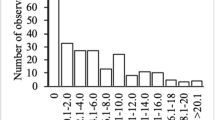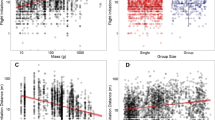Abstract
Flight initiation distances (FIDs) of nesting birds approached by a predator likely reflect evolutionary stable strategies in which birds make trade-offs between adult survival and reproductive success. Here, we test if FID (a) had an impact on hatching success, (b) was adjusted to current conditions, and (c) was consistent for individual nests. All experiments were performed with a human approaching incubating Eurasian curlews Numenius arquata, a ground-nesting wader species under high egg predation pressure. Our results show that hatching success was higher in nests where the incubating parent left at intermediate FIDs compared to short and long ones, and that FID decreased with date and time of the evening. Further, FIDs from repeated approaches were not consistent within nests. We suggest that incubating Eurasian curlews follow a “surprise” strategy, where an element of randomness is superimposed on a context-adjusted norm to prevent predators from predicting their FID behaviour.




Similar content being viewed by others
References
Beale CM, Monaghan P (2004) Human disturbance: people as predation-free predators? J Appl Ecol 41:335–343
Berg Å (1994) Maintenance of populations and causes of population changes of Curlews Numenius arquata breeding on farmland. Biol Conserv 67:233–238
Biermann GC, Robertson RJ (1981) An increase in parental investment during the breeding season. Anim Behav 29:487–489
Blumstein DT, Anthony LL, Harcourt R, Ross G (2003) Testing a key assumption of wildlife buffer zones: is flight initiation distance a species-specific trait? Biol Conserv 110:97–100
Blumstein DT, Fernández-Juricic E, Zollner PA, Garity SC (2005) Inter-specific variation in avian responses to human disturbance. J Appl Ecol 42:943–953
Busche G (2011) Brutbestandstrends vom Grossen Brachvogel (Numenius arquata) und anderen Wiesenlimikolen: starke Rückgänge auf Grünland im Western Schleswig-Holsteins von 1968 bis 2005. Vogelwarte 49:1–8
Camfield AF, Martin K (2009) The influence of ambient temperature on horned lark incubation behaviour in an alpine environment. Behaviour 146:1615–1633
Clark CW, Ydenberg RC (1990a) The risk of parenthood. I. General theory and applications. Evol Ecol 4:21–34
Clark CW, Ydenberg RC (1990b) The risk of parenthood. II. Parent-offspring conflict. Evol Ecol 4:312–325
Cooper WE (2008) Visual monitoring of predators: occurrence, cost and benefit for escape. Anim Behav 76:1365–1372
Cooper WE, Frederick WG (2007) Optimal flight initiation distance. J Theor Biol 244:59–67
Cooper WE, Whiting MJ (2007) Universal optimization of flight initiation distance and habitat-driven variation in escape tactics in a Namibian lizard assemblage. Ethology 113:661–672
Cramp S (ed) (1983) Handbook of the birds of Europe, the Middle East and North Africa. The birds of the Western Palearctic, vol 3. Oxford University Press, Oxford
Currie D, Valkama J, Berg Å, Boschert M, Norrdahl HM, Korpimäki E, Pöyri V, Hemminki O (2001) Sex roles, parental effort and offspring desertion in the monogamous Eurasian Curlew Numenius arquata. Ibis 143:642–650
Dingemanse NJ, Réale D (2005) Natural selection and animal personality. Behaviour 142:1165–1190
Dingemanse NJ, Kazem AJN, Réale D, Wright J (2009) Behavioural reaction norms: animal personality meets individual plasticity. Trends Ecol Evol 25:81–89
Eason PK, Sherman PT, Rankin O, Coleman B (2006) Factors affecting flight initiation distance in American robins. J Wildl Manag 70:1796–1800
Frid A, Dill L (2002) Human-caused disturbance stimuli as a form of predation risk. Conserv Ecol 6: 11. http://www.consecol.org/vol6/iss1/art11
Glutz von Blotzheim UN, Bauer KM, Bezzel E (eds) (1977) Handbuch der Vögel Mitteleuropas Band 7, Teil2. Akademische Verlagsgesellschaft, Wiesbaden [In German]
Kramer DL, Bonenfant M (1997) Direction of predator approach and the decision to flee to a refuge. Anim Behav 54:289–295
Kresinger J, Albrecht T (2008) Nest protection in mallards Anas platyrhynchos: untangling the role of crypsis and parental behaviour. Funct Ecol 22:872–879
Lima SL (2009) Predators and the breeding bird: behavioral and reproductive flexibility under the risk of predation. Biol Rev 84:485–513
Lima SL, Dill LM (1990) Behavioral decisions made under the risk of predation: a review and prospectus. Can J Zool 68:619–640
MacDonald MA, Bolton M (2008) Predation on wader nests in Europe. Ibis 150(Suppl 1):54–73
Madsen J, Boertmann D (2008) Animal behavioral adaptation to changing landscapes: spring-staging geese habituate to wind farms. Landscape Ecol 23:1007–1011
McLeod AI (2011) Kendall: Kendall rank correlation and Mann-Kendall trend test. R package version 2.2. http://CRAN.R-project.org/package=Kendall
Møller AP, Garamszegi LZ (2012) Between individual variation in risk-taking behavior and life history consequences. Behav Ecol 23:843–853
Montgomerie RD, Weatherhead PJ (1988) Risks and rewards of nest defence by parent birds. Q Rev Biol 63:167–187
Newcombe RG (1998) Interval estimation for the difference between independent proportions: comparison of eleven methods. Stat Med 17:873–890
Nisbet ICT (2000) Disturbance, habituation and management of waterbird colonies. Waterbirds 23:312–332
R Development Core Team (2011) R: a language and environment for statistical computing. R Foundation for Statistical Computing, Vienna, Austria. ISBN 3-900051-07-0. http://www.R-project.org/
Reneerkens J, Piersma T, Damsté JS (2005) Switch to diester preen waxes may reduce avian nest predation by mammalian predators using olfactory cues. J Exp Biol 208:4199–4202
Sarkar D (2008) Lattice: multivariate data visualization with R. Springer, New York
Seppänen J-T, Forsman JT, Mönkkönen M, Thomson RL (2007) Social information use is a process across time, space and ecology, reaching heterospecifics. Ecology 88:1622–1633
St Clair JJH, García-Peña GE, Woods RW, Székely T (2010) Presence of mammalian predators decreases tolerance to human disturbance in a breeding shorebird. Behav Ecol 21:1285–1292
Stankowich T, Blumstein DT (2005) Fear in animals: a meta-analysis and review of risk assessment. Proc R Soc Lond B 272:2627–2634
Statistics Sweden (2010) Statistical yearbook of Sweden 2010. Örebro, Sweden [In Swedish]
Webb NV, Blumstein DT (2005) Variation in human disturbance differentially affects predation risk assessment in Western Gulls. Condor 107:178–181
Ydenberg RC, Dill LM (1986) The economics of fleeing from predators. Adv Stud Behav 16:229–249
Acknowledgments
This study was made possible by a grant from C.F. Lundströms Stiftelse (CM) and financial support from the Faculty of Forest Sciences, Swedish University of Agricultural Sciences (CGT). We wish to thank the ten assistants for late hours in the field, Sören Holm and Kjell Leonardsson for statistical advice, and Ruth Nichols for improving the quality of the text. Comments and suggestions from Juha Tiainen, Jari Valkama, one anonymous referee and the associate editor greatly improved the manuscript. The experimental design was approved by the Umeå Ethical Committee on Animal Experiments (permissions A25-09 and A35-10A).
Ethical standards
The authors declare that this publication complies with the current laws of the country in which the experiment was performed (Sweden).
Conflict of interest
The authors declare that they have no conflict of interest.
Author information
Authors and Affiliations
Corresponding author
Additional information
Communicated by P. A. Bednekoff
Rights and permissions
About this article
Cite this article
de Jong, A., Magnhagen, C. & Thulin, CG. Variable flight initiation distance in incubating Eurasian curlew. Behav Ecol Sociobiol 67, 1089–1096 (2013). https://doi.org/10.1007/s00265-013-1533-6
Received:
Revised:
Accepted:
Published:
Issue Date:
DOI: https://doi.org/10.1007/s00265-013-1533-6




